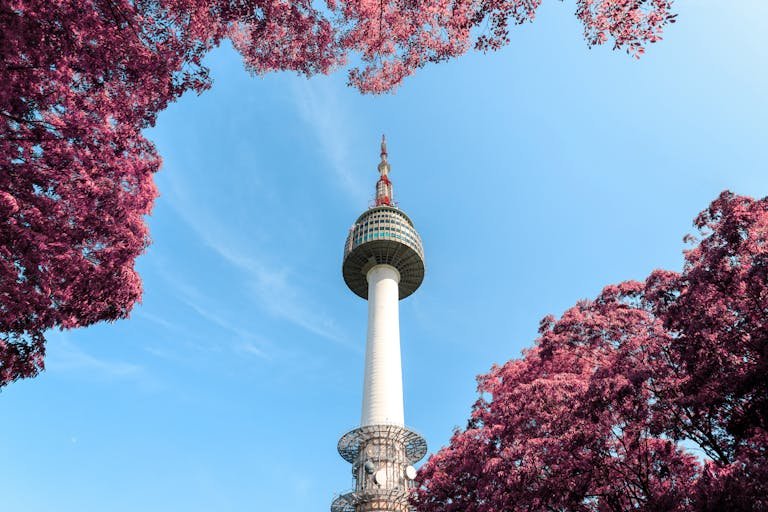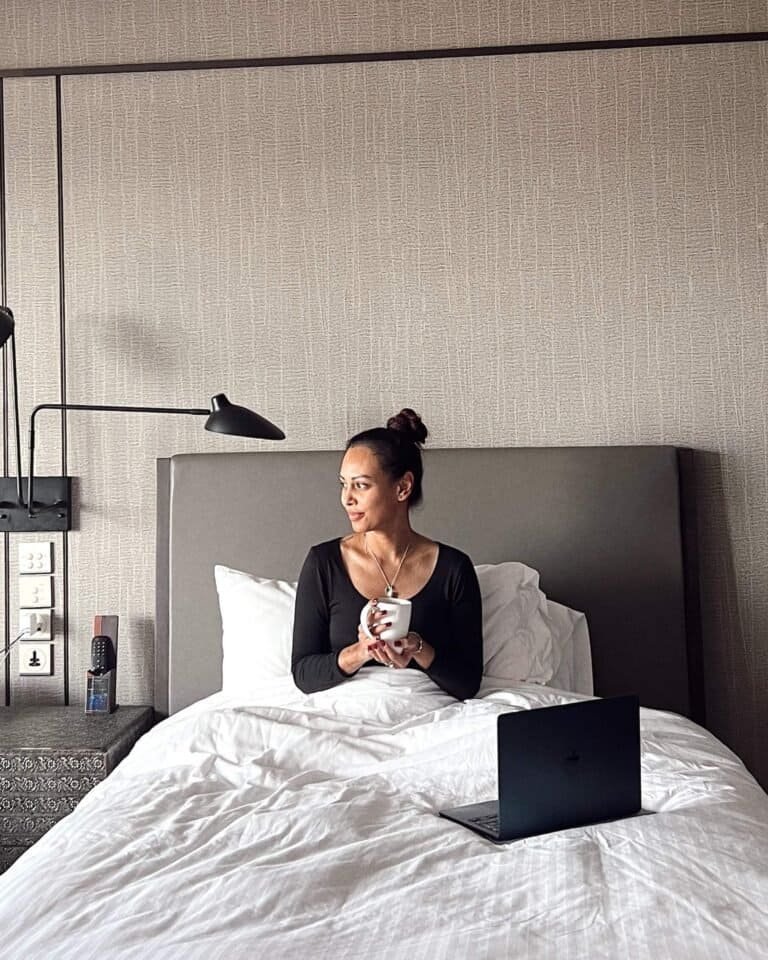The Ultimate Solo Female Travel Guide To Kyoto For First-Time Visitors
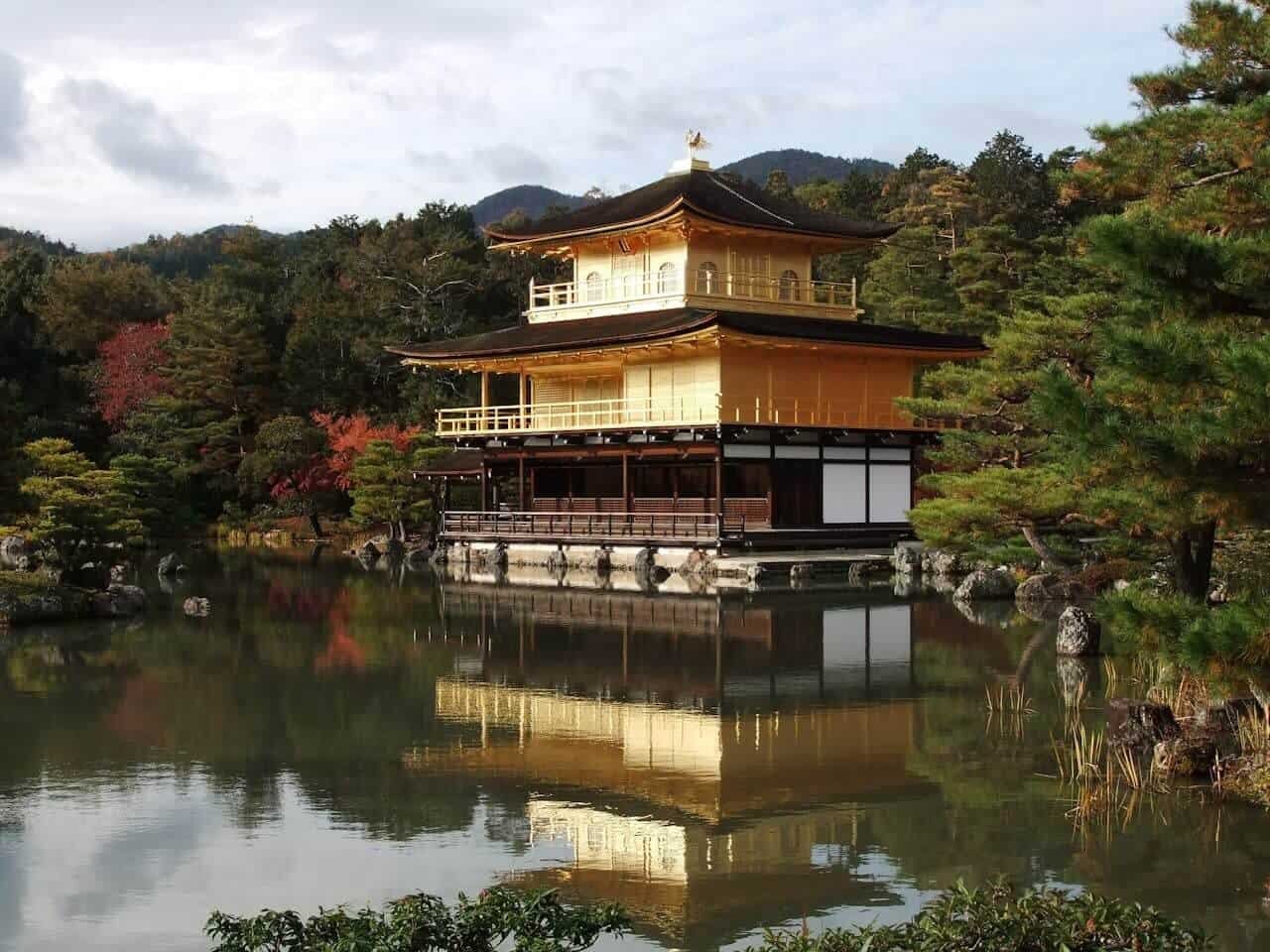
This post may contain affiliate links. That means if you click and make a purchase, I may earn a small commission at no extra cost to you. I appreciate your support!💙
This is your ultimate solo female travel guide to Kyoto! After years of dreaming of Japan, I finally made my number-one bucket list destination a reality in September 2023.
I devoted an entire blog post to Kyoto to provide the best information about female solo travel in Kyoto. Kyoto has become one of my favourite cities, a different vibe from neon-lit Tokyo.
In contrast, Tokyo is a vibrant, busy city. But despite the crowds, Kyoto is about authenticity, which translates into geishas, Japanese gardens, and beautiful temples and shrines.
I fell madly in love with Japan the first time that I visited again, only six months later. Japan is popular and has seen a massive influx of tourism over the last few years.
In this post, I’ll walk you through everything you need to know about travelling to Kyoto, Japan, alone as a woman. We’ll dive into safety, things to do, how to get around and more. I hope that after reading this, you’ll love Kyoto as much as I do!
Please read this guide from the official Tourism Board Japan on customs and etiquette in Japan, it will give you a head start on Japanese culture and customs.
👉🏽 Don’t forget to check out my 2-day itinerary to Kyoto and my 2-week solo itinerary to Japan.
- ⛑️ Do NOT travel without travel insurance: Check out Safety Wing for reliable travel insurance.
- 🏨 Stay in Seikoro Ryokan or Henn Na Hotel.
- 🫖 Book a traditional tea ceremony in a tea house.
- ✈️ Book your ticket to Kyoto with Skyscanner.
- 🎰 Find the best tours and excursions to Kyoto with the flexible Get Your Guide.
- 🎫 Book your train tickets for Kyoto easy online via Klook.
- 🚲 Book a guided full-day bike tour that covers most highlights in Kyoto.
- 14 Surprising Things to Know Before Travelling To Japan: Respect The Culture Like A Pro
- The Ultimate 2-Day Highlights Itinerary To Traditional Kyoto
- Don’t Miss These Fantastic Boutique Hotels in Kyoto for A Unique Trip
- 9 Expert Reasons Why Japan is Fantastic for Solo Female Travel
- The Best 6 Top-Rated Food Tours in Osaka: Taste Japanese Cuisine
- Discover The Best Tours To Mount Fuji In Japan For An Epic View
- How To Use Public Transport In Japan: Do Not Get Lost
- The Perfect One-Day Itinerary To Kyoto
- The Ultimate 2-Week Solo Itinerary: First Time in Japan
- The Ultimate Solo Female Travel Guide To Kyoto
- The Perfect 5-day Itinerary to Tokyo: The Highlights
- 3 Days in Tokyo: see, eat and explore it all
- My Highlights 10-Day Itinerary to Japan: Tokyo, Kyoto, Osaka & Mount Fuji
Is Kyoto safe for solo female travellers?
Yes, Kyoto is very safe for solo female travellers. Japan is one of the safest countries in the world for women travelling alone. I’ve never felt unsafe in Japan. I found the Japanese people friendly, helpful and polite.
It’s one of the few countries where I don’t have to worry about someone running off with my camera or phone while setting it up on my tripod to take photos by myself. I did that on a crowded Shibuya Crossing, something I would never feel comfortable doing anywhere in the United States.
However, this doesn’t mean you should be looking for trouble. Always pay attention to your surroundings, lock your door and don’t do dumb things. Every destination deserves basic safety precautions.
I think that Kyoto is great for solo travellers because even the locals do many things alone. Most of the time, there are counter/ bar seats when eating out, and there are solo yakiniku restaurants.
Eating out alone or having a drink is pretty common in Kyoto and Japan in general. One evening, I went out for a drink in a quiet jazz bar in Kyoto, talking with the bartender about Ella Fitzgerald.
Where to stay in Kyoto as a solo female traveller?
Kyoto is not as big as Tokyo or Osaka, so researching how to choose your hotel should take less time. Most highlights in Kyoto are fairly centred in the same area.
However, this still means you’ll have to walk quite a bit in Kyoto. The subway system is less extensive, but more on public transport later.
Some of the main highlights are situated in areas where there are no subway stations or even bus stations. So, get your walking shoes on.
The areas in Kyoto are a little hard to pinpoint because they’re quite big. So, I’ve narrowed it down to certain landmarks. If you travel solo in Kyoto, I recommend staying in these areas.
👉🏽 If you love a more unique stay, check out these fantastic Boutique Hotels in Kyoto!
Kyoto Station
Kyoto Station is the train station in Kyoto. Staying near Kyoto Station means being close to all train and subway lines.
There are also plenty of restaurants, shops and convenience stores nearby. I stayed in a hotel within a 5-minute walking distance from Kyoto Station. This helped me get to places faster because I had fast access to the subway and trains.
APA Hotel Kyoto Eki Higashi
I enjoyed staying at APA Hotel Kyoto Eki Higashi because of its great location, good price, and clean rooms with all the amenities you could dream of.
The only downside is that the rooms are small (11m2, which is fairly normal for budget hotels in Japan). If you’re travelling alone, this shouldn’t be an issue.
Besides the small room, APA Hotel Kyoto Eki Higashi has everything you need! Awesome facilities, clean rooms and new amenities daily (they hang a bag on the door if you don’t need cleaning), vending machines, convenience stores nearby and a 5-minute walk to Kyoto Station!
Wander Kyoto Nanajo
Wander Kyoto Nanajo is a good, affordable hotel with great reviews. It’s a 10-minute walk from Kyoto Station. The rooms are bigger than the previous APA hotel, making them more comfortable for a slightly higher price.
The location is just as convenient, and it’s a great budget option for solo female travellers.
Southern Higashiyama Kyoto
This area is a little farther away from Kyoto Station but closer to the main highlights, in my opinion. Staying in Southern Higashiyama means you’re in the middle of it all and could do a lot on foot if you like walking.
From Gion to Kyoto Station is a 45-minute walk. It’s not close by, but it’s doable if you’re doing some sightseeing along the way.
Sarah’s Favourite
Seikoro Ryokan
To immerse yourself in the Kyoto experience, consider spending a few nights at a traditional ryokan. Seikoro Ryokan consistently receives glowing reviews and boasts a superb location conveniently situated near Sannenzaka, Gion, and Nishiki Market, with a subway station nearby. It’s popular, so book in advance to secure your stay!
Hotel The Celestinex Kyoto Gion
I stayed at The Celestine Kyoto Gion and felt so safe and spoiled. It’s a peaceful gem with an onsen, stylish rooms, and a luxe tempura restaurant. Just a short walk from Gion and Kiyomizu-dera, it’s ideal if you want boutique comfort without sacrificing location or solo travel safety.
Henn Na Premier Gojo Hotel
I stayed at the Henn Na Premier hotel on my second stay in Kyoto in March 2024. This hotel has excellent reviews and a great price. It’s located near a subway station for easy access and about a 25-minute walk to Kiyomizu-dera. The rooms in Henn na Premier are comfortable in size, so there’s no need to feel cramped.
It is a great location, affordable, and perfect for travelling solo. I enjoyed staying at the Henn Na Premier Hotel.
Hotel GOCO stay Kyoto Shijo
This highly reviewed hotel is located smack in the middle of it all! If you’re based at Hotel Goco Stay Kyoto, you can do a lot on foot. It’s within walking distance from Gion, Kiyomizu-dera, Pontocho and around the corner of Nishiki Market.
The rooms are beautiful and spacious. And how great it is to walk home after dinner in Pontocho?
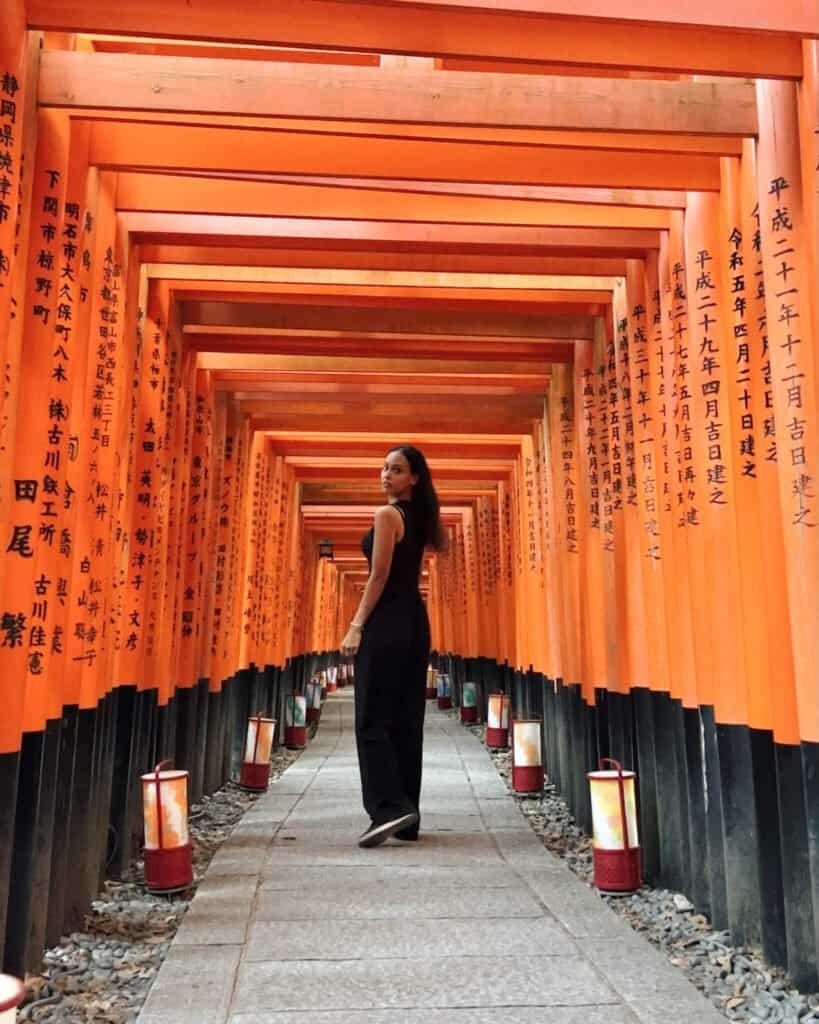
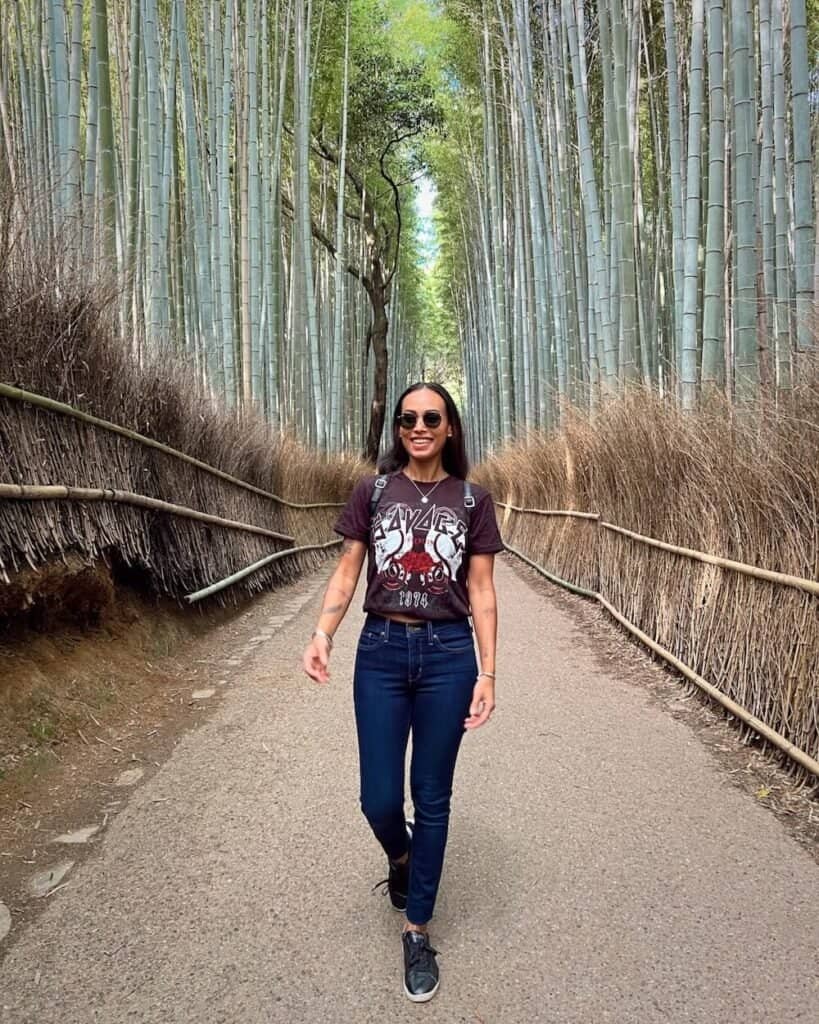
How many days in Kyoto is enough?
I suggest staying in Kyoto for at least 3 full days. This way, you’ll have the mornings to explore the most iconic highlights (without the crowds) and the rest of the days to explore the city at a relaxed pace.
While Kyoto isn’t as big as Kyoto or Osaka, there’s still much to see. Decide what your interests are and what you want to do. Kyoto can get very crowded after 10:00 because of the tour buses rolling in from Osaka, so keep that in mind.
To beat the crowds, it’s best to wake up early and go to any specific sights just after sunrise. You’ll get a quiet morning and photos without lots of people in them. I woke up almost every day around 5:30 AM.
If you’re short on time, I suggest staying at least 2 days in Kyoto to hit all the highlights,
Public Transport in Kyoto
Getting around Kyoto is super easy thanks to its efficient and reliable public transport system. While the city isn’t as subway-heavy as Tokyo or Osaka, you’ll find an excellent network of buses, local trains, and a couple of subway lines that make exploring the main sights a breeze.
For temples like Kinkaku-ji, the bus is your best bet—even though it can get crowded during peak season. You can use your Suica card (you can use it in multiple cities) or a one-day Kyoto Bus & Subway Pass if you’re planning to cram a lot in.
As a solo female traveller, I always felt completely safe on public transport here, even late in the evening. I’ve written an entire blog post on how to use public transport in Japan, so head over there for a better explanation.
Things to do in Kyoto for solo female travellers
I love Kyoto’s traditional Japanese vibe compared to Tokyo’s busy, neon-lit streets. Don’t get me wrong, though. Kyoto can be extremely busy, especially around the tourist highlights.
I’ve listed these must-see highlights in the ultimate solo female travel guide to Kyoto. Yes, they are touristy, but that doesn’t make them any less beautiful.
Fushimi Inari
Fushimi Inari is probably the most iconic sight in Japan. I remember that Fushimi Inari was the first sight I saw online that made me want to visit Japan!
Fushimi Inari is famous for the endless red tori gates, which cannot be missed in Kyoto. The subway is very accessible, and it’s just a short walk to the entrance.
Come early to beat the crowds, because it’s so crowded during the day (think sardines in a can). This means being there no later than 06:30 or preferably around sunrise. Also, walk towards the end of the gates, where it’s less crowded.
People tend to stop at the beginning, while the best shot is at the end. You can walk up to the summit, where you’ll find more tori gates and kitsune statues. The higher up you go, the quieter it gets.
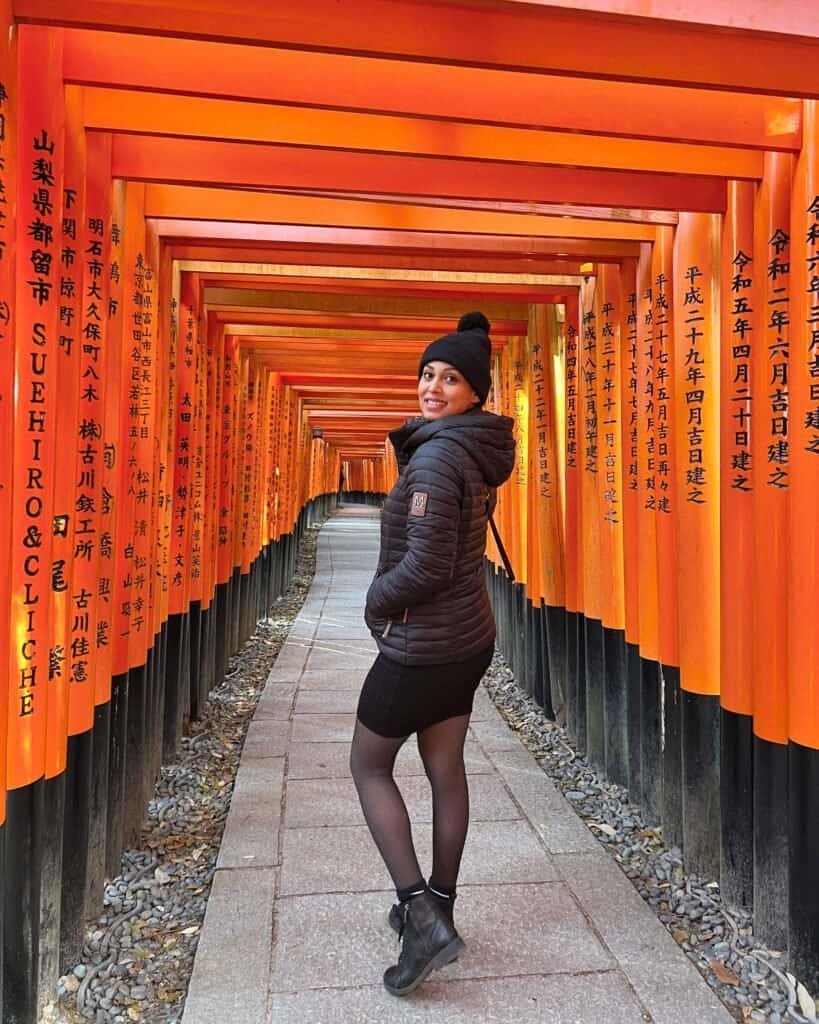
Kiyomizu-Dera Temple
Kiyomizu-dera Temple is one of the sights located together with Hokan-ji Temple and Sannenzaka/ Ninnenzaka. Perfect to visit all of them together.
These areas can get super crowded during the day because the tour buses roll in around 10:00. So again, start your day early to beat the crowds.
Kiyomizu-dera is quite big, with many places to cover and fantastic dragon statues. There’s supposed to be an amazing view during sunset; unfortunately, I missed it.
Hokan-ji Temple
Hokan-ji Temple is another iconic sight in Kyoto, tucked away in the streets about 15 minutes from Kiyomizu-dera.
The temple is great for some fantastic photos; you’ll probably see people lining up! Hōkan-ji Temple, also known as Yasaka Pagoda, is a five-story pagoda in Kyoto’s historic Higashiyama district.
It dates back to the 6th century and stands as a peaceful symbol, and its silhouette is a popular photo spot, especially during cherry blossom season or sunset strolls.
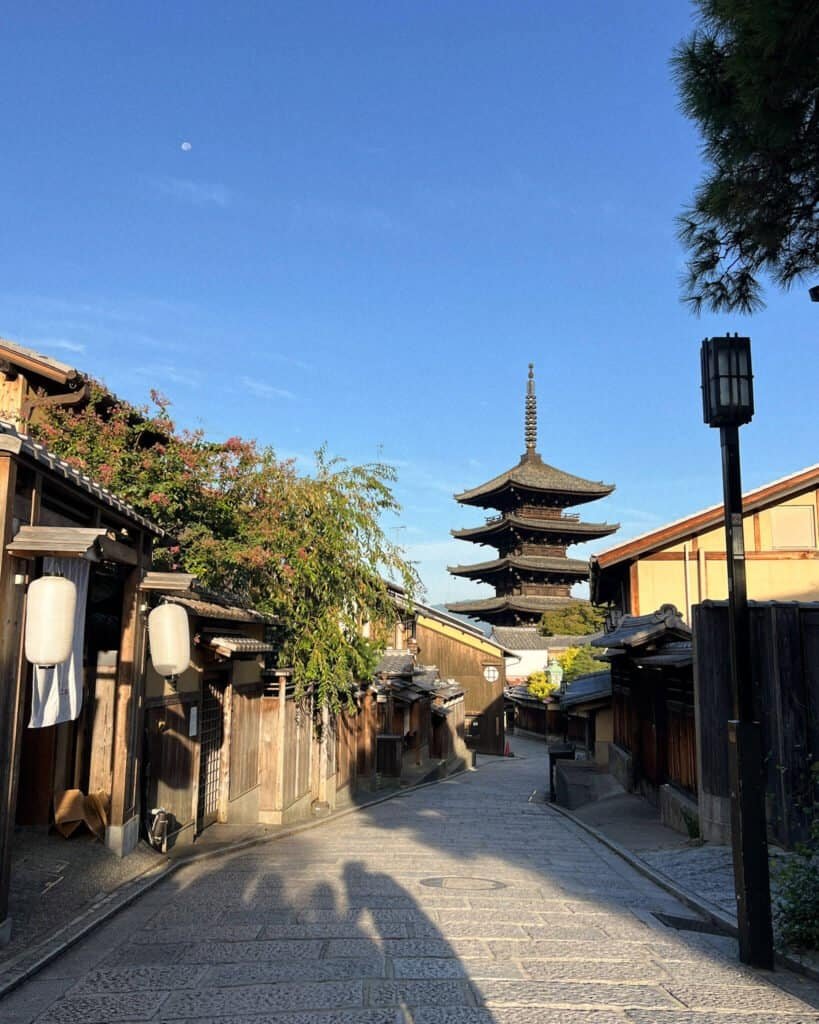
Sannenzaka/ Ninnenzaka
Roaming the streets of Sannenzaka/Ninnenzaka gives you the feeling of being in ancient Japan. During the day, the streets are crazy busy, but if you arrive early, you can find some empty streets.
You’ll probably recognise some streets and corners from very Instagrammable photos. You’ll also find places to eat and drink, and many shops.
There is a famous Starbucks with a traditional interior that opens at 8:00 AM, which is a great experience. I’m not the one to wait in line for just a Starbucks, so I skipped it. But it’s a great experience and a great move from Starbucks.
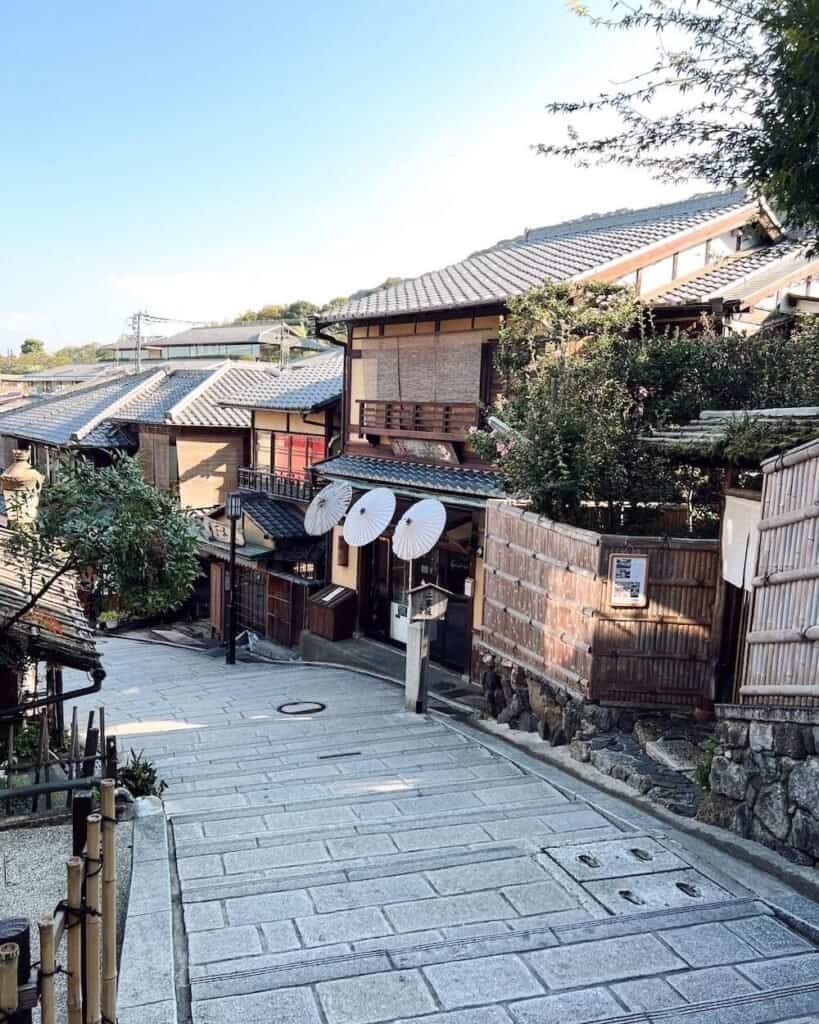
Gion District
Gion is Kyoto’s famous geisha district, known for its machiya houses, teahouses, and narrow cobblestone streets. It comes alive in the evening, with glimpses of a geiko in a traditional kimono.
The best time to stroll around is at the end of the day or in the evening. The main street in Gion is Hanami-koji Lane. Please be respectful in this area and do not go onto the private streets.
Respect the geishas (if you can spot one) and don’t harass them or take their photos without permission.
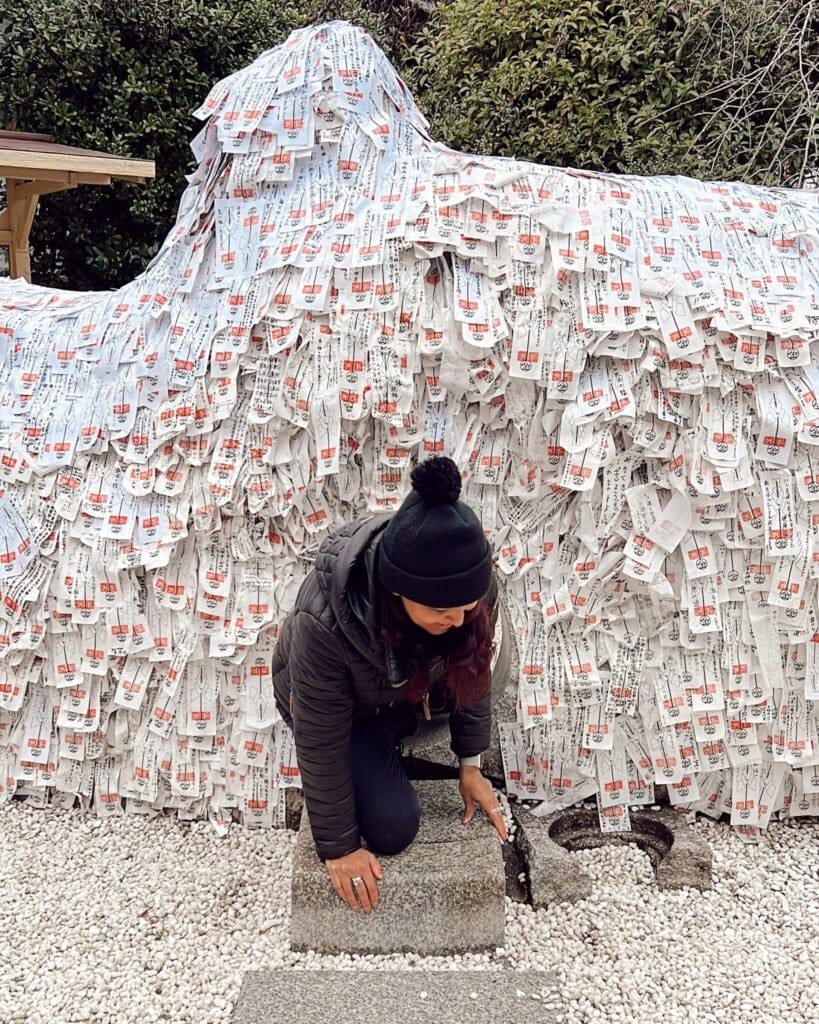
Arashiyama Bamboo Forest
The bamboo forest is a 30-minute subway ride northwest of Kyoto. The area with a lot of bamboo trees is a few streets away. It’s still very cool to see and to take photos of.
You can find some gardens and smaller temples in the rest of the bamboo forest, but like everything else in Kyoto, expect it to be busy.
Kinkaku-ji Temple
This temple is slightly different from others because of its golden appearance, but it is yet another beautiful one. Kinkaku-ji, or the Golden Pavilion, is a stunning Zen Buddhist temple in Kyoto.
Covered in gold leaf, it reflects beautifully over the surrounding pond. Originally a shogun’s villa, it became a temple in 1408. The gardens and striking architecture make it one of Kyoto’s most iconic sights.
Day trips to take from Kyoto
To add a little flair to this ultimate solo female travel guide to Kyoto, I’ve added a few day trips that are worth visiting if you have the time.
Nara Deer Park
Have you ever come across those videos of deer bowing for a snack? That’s Nara Deer Park, a great day trip from Kyoto, Japan. Nara is only 45 minutes away from Kyoto Station by train.
If you’re just visiting Nara Deer Park, you could easily do this in the morning. Be careful, though. The deer are used to people and can get a little crazy. They’re still wild animals.
Before you enter the park, you’ll see different stalls selling packs of deer cookies for you to feed the deer. If you’re just visiting the deer, you can easily do Nara Deer Park in 1.5 hours.
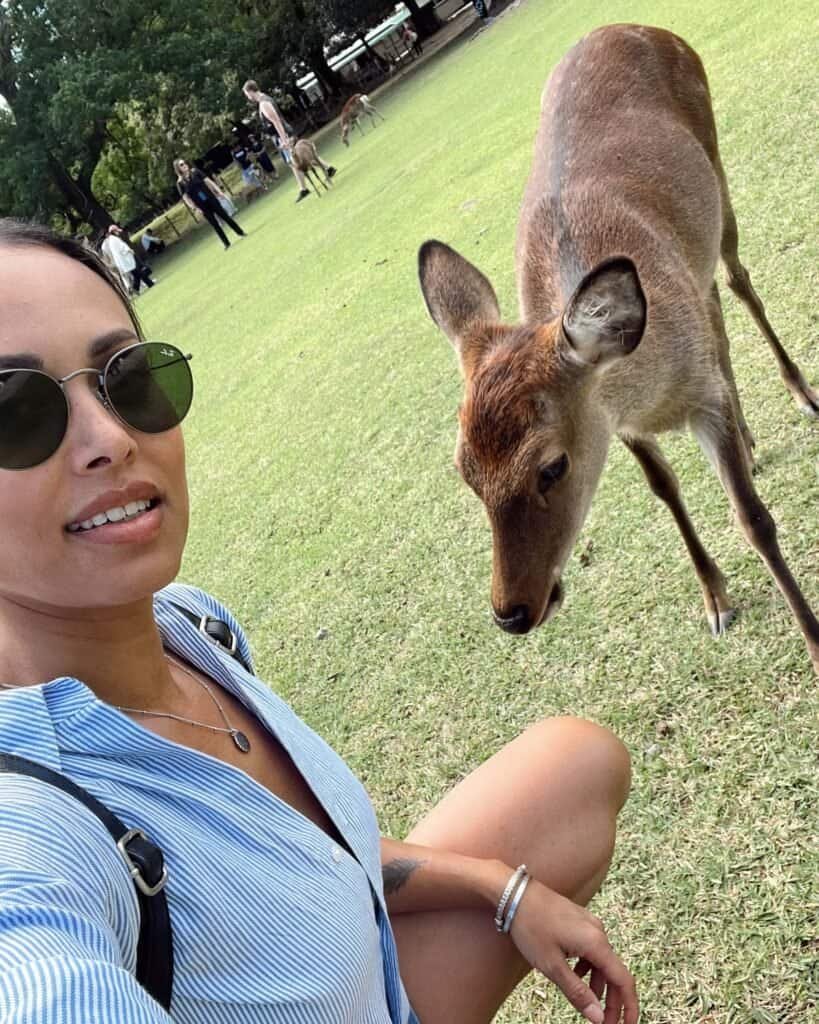
The best tours in Kyoto
Kyoto is a great city to explore by yourself, but there are also some fantastic tours and activities to sign up for! And honestly, you can’t leave Japan without a cooking class!
These well-arranged tours are a must in the ultimate solo female travel guide to Kyoto. All you have to do is sit back and let everything take care of itself!
Kyoto Bento Cooking Class
Bento boxes are a typical Japanese lunch meal. This Kyoto Bento Cooking class is just as fantastic as a bento box! Bento boxes are like the Avengers of Meals – carbs, protein, and a bunch of colourful veggies and fruits all in one squad.
During this cooking class, you will learn how to make your own bento box and get to enjoy it for lunch! A fun morning class in Kyoto that includes lunch.
The English-speaking chef will tell you about the Bento Box’s cultural background. It is a great and delicious experience to spend your morning in Kyoto!
Kyoto Highlights Bike Tour
I’ve said it before. Kyoto is a great city to explore on a bike. This Kyoto Highlights Bike Tour lasts a whole day and takes you to the most iconic highlights in Kyoto with a guide!
The tour takes about 8 hours and includes a small lunch. You’ll start your day in Arashiyama Bamboo Forest and make your way to Fushimi Inari, Kiyomizu-dera, Gion and Kinkaku-ji.
You’re tackling all the major sights in Kyoto! A great way to explore Kyoto!
Kyoto Tea Ceremony Ju-An at Jotokuji Temple
Take in the experience of the art of tea drinking in this traditional Japanese tea ceremony at Jotokuji Temple. The Tea Master will tell you all about its social significance in Japanese culture.
You can also rent a kimono to be fully immersed in the Kyoto Tea Ceremony Ju-An at Jotokuji Temple!
Kyoto Sake Brewery Tour with Food Pairing
Are you new to Sake? Or maybe you are a sake lover? Either way, visiting a sake brewery is a must when in Japan! This Kyoto Sake Brewery Tour with Food Pairing is the perfect way to learn more about the world of sake.
Get ready to savour sake like never before! You’re diving into uncharted sake territory, unveiling bottles that have never been exported. Your guide will spill the tea on the taste spectrum – from dry to fruity to sweet – and spill the secrets of how these flavours are crafted.
How to get around in Kyoto
Public transport
Kyoto is a city where you’ll be walking a lot! There is a subway system, but some parts are not well-connected, so you still have to walk from the subway station.
I found it easier to walk between certain sights because it wasn’t that much longer than taking the subway. However, the subway is cheap and great for getting around.
Taxis
Taxis are affordable in Kyoto compared to Tokyo. It can be convenient to take a taxi from certain sights to another, for example, from Fushimi Inari to Hokan-ji Temple or Sannenzaka.
It saved me a lot of time and was worth the $9! Uber works perfectly in Japan, so there is no need to download another cab app.
Bike
While many people in Japan ride bikes in general, Kyoto is the perfect city to rent a bike. Getting around between sights will be much easier than constantly taking a subway and walking.
Pay attention to the rules for bike use and parking locations. You’re not allowed to park your bike anywhere; you must use designated spaces.
The streets are fairly quiet, and there isn’t a lot of traffic most of the time; biking around should be comfortable.

Note: Kyoto often experiences heavy crowds, especially with day-trip tour buses arriving from Osaka. To maximise your experience and capture crowd-free photos, it’s best to rise early. Aim to arrive at the key attractions no later than 6:30 a.m. Trust me, it’s worth the early start.
Where to eat in Kyoto for solo travellers
Nishiki Market
Nishiki Market is a semi-indoor market with lots of food shops and stalls. Here, you can buy anything from fresh products to Wagyu skewers and sushi.
The market itself is one long street that opens in the morning and closes by the end of the afternoon. It’s a great area to have lunch or even breakfast.
A food stall sells Kobe and Wagyu beef skewers for a reasonable price, and you can get yourself a mango sour from the stall across. All for maybe a little over $20. It’s the perfect place for breakfast or lunch.
Cafe BAW
If you’re looking for an amazing place to satisfy your sweet tooth, check out Cafe 2D Tearoom BAW. Its interior is in 2D, and luckily for this Instagrammable gem, the food is actually to die for!
I had a set menu with delicious chocolate ice cream and coffee. I still dream about the croffle and can’t wait to try more of their desserts.
Chao Chao Sanjo Kiyamachi
I loved this place, and I wasn’t the only one. There’s almost always a queue outside the restaurant. There’s table seating, but you can also sit at the bar (perfect for solo travellers).
Chao Chao Sanjo Kiyamachi offers different types of gyoza, great prices, and fantastic staff!
Yakitori Otonari
There are many yakitori restaurants in Kyoto. But I stumbled upon Yakitori Otonari after visiting Sannenzaka/ Kiyomizu-dera. They have all kinds of yakitori, nice beers and sake, and an English menu.
I would definitely go back here when I’m in Kyoto again.
Wagyu Sushi Roll
Wagyu Sushi Roll is a great place to have lunch after a visit to Fushimi Inari! The restaurant opens at 11:00 and is famous for its Wagyu beef rolls! The subway station is nearby.
Besides Wagyu Sushi, they have different kinds of rolls and an English menu!
Restaurant Alley/ Pontocho
Restaurant Alley is a street along the river with many restaurants, from mid-range budget restaurants to the pricier ones. There are lots to choose from, and you can start with a drink in one of the nearby bars.

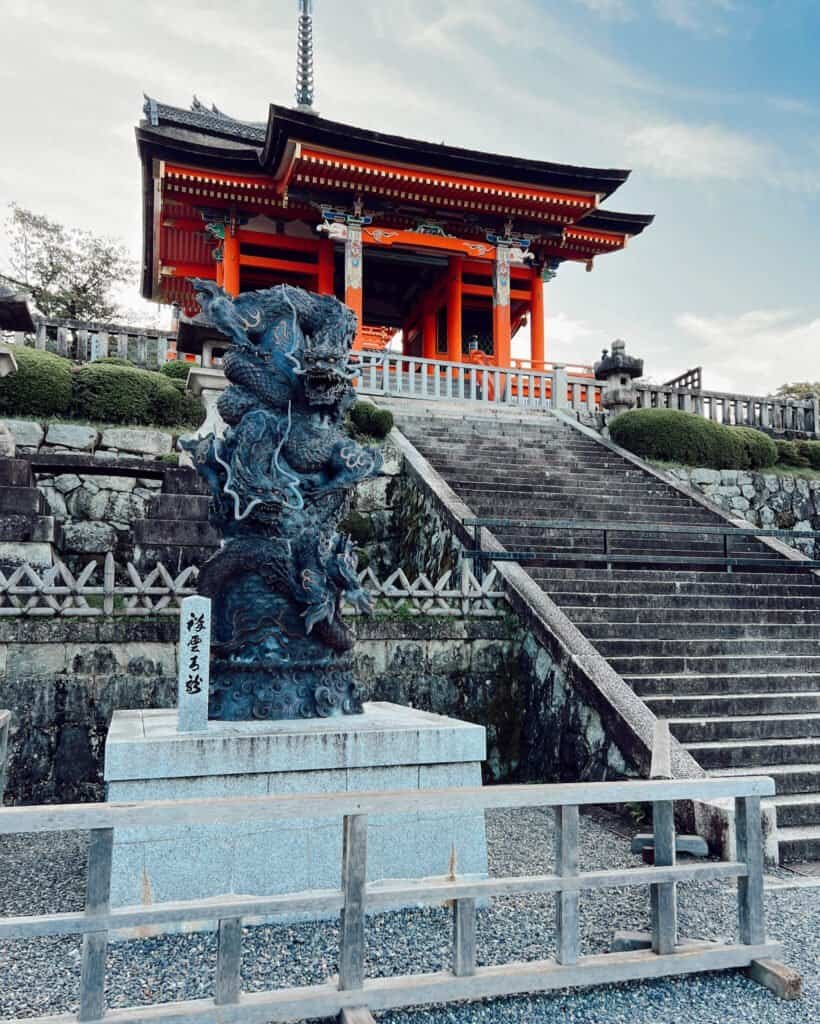
What is the best time to visit Kyoto?
I visited Kyoto in late September, and the weather was lovely! It was a little chilly early in the morning, but the daytime temperature was 22 degrees Celsius. When the sun finally comes out, it can get really warm. It was those perfect after-summer days in September.
Kyoto is great to visit from spring to fall. The cherry blossom season (late March/ April) and fall foliage season (November) are especially popular. These months are busy and more expensive.
I also visited Kyoto in late March, and even though the weather was colder than expected, I really enjoyed the time. It was perfect for sightseeing, but the evenings were pretty cold.
What to pack for Kyoto?
If you’re travelling between spring and fall, I recommend wearing layers: shorts, t-shirts, a light jacket or blouse, breathable long pants, and comfortable walking shoes. A small umbrella for certain rainy months, like June and the end of September, would be useful.
Summers will be very hot, so wear a cap or use an umbrella as a parasol. Always bring a backpack with a separate plastic bag for your trash. Japan has barely any trash cans on the streets. You take it home with you and throw it away there.
How English-friendly is Kyoto?
Kyoto is very English-friendly. Kyoto is one of the most popular tourist destinations in Japan. Most people speak English, even a little bit. If you’re worried about a language barrier, don’t be. You’ll manage, trust me.
In my experience, people do their best to communicate. If they can’t speak English, they will use a translation app. My Uber drivers were all super friendly and tried to speak English.
Is it safe to walk around Kyoto at night?
Japan, in general, must be one of the safest countries in the world. You can walk safely around Kyoto, even at night. I never felt uncomfortable or unsafe walking around Kyoto. Always practise standard safety measures, even if a country or city is safe.
How to get to Kyoto
Train
Kyoto is about a 2-hour train ride from Tokyo by Shinkansen. The fastest bullet train is Nozomi. A train leaves Tokyo every 15 minutes, and you can get on at Tokyo Station or Shinagawa Station.
I bought my train ticket through the ticket machines at one of the JR train stations. The ticket machine is in English, and it’s very self-explanatory.
Use Google Maps and type in your location to Kyoto Station. Google Maps will tell you which station is the easiest to get to on the train.
Buy your train ticket a few days in advance! This way, you can reserve a window seat on the left side of the train. This side has the best views, and you might be lucky enough to see Mount Fuji. Unfortunately, I booked my ticket a little too late.
A one-way ticket directly from JR is about $95/ €90. You can also easily book your Kyoto train tickets online via Klook. This website is user-friendly for English speakers, so it might be worth checking out.
Plane
You can also fly into Osaka and then take a train to Kyoto. Multiple flights connect Tokyo and Osaka every day. I feel that the train ride is a nice experience and there’s no airport stress.
But, if you’re on a tight budget, booking plan tickets might be much cheaper and faster.
The train from Osaka to Kyoto is only 20 minutes long. Flights depart from Haneda Airport; booking in advance will get you an affordable ticket.
Plan your trip
With my online resources
Use my travel planning roadmap with all my digital resources to book every detail of your trip!
Ready for your solo travel adventure in Kyoto?
I hope this ultimate solo female travel guide to Kyoto will help you on your way to Kyoto! It is one of my favourite cities in the world. I love the authentic vibe and the beautiful temples and shrines.
Check out this page for any events and activities going on in Kyoto while you’re there and always check out the current visa requirements for Japan.
Ready to dive in more about Kyoto? Read this next:
- The Ultimate 2-Day Itinerary To Kyoto Guide For First-Time Travellers
- 6 Gorgeous Boutique Hotels in Kyoto For Women That Are Solo-Friendly (2025)
- My Highlights 10-Day Itinerary to Japan: Tokyo, Kyoto, Osaka & Mount Fuji
Kyoto and Japan is safe for solo female travellers. There is Japanese culture, great food, beautiful temples, and enough to do to keep you busy for days. I hope you’ll love it as much as I do.



